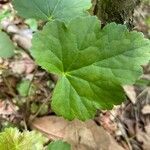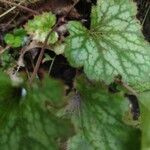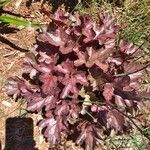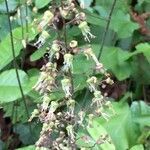Plants 4–14 dm; scape with a few small, scale-like bracts; petioles glabrous to minutely glandular-puberulent, seldom with a few longer spreading hairs; lvs often white-mottled, variously hairy or glabrous, 5–9-lobed with lobes of various depths, often pentagonal in outline, the teeth rounded to acute, mucronate; stem glandular in the infl, otherwise glabrous; fls only slightly oblique, 3–7 mm (to the sep-tips), the free part of the hypanthium 0.5–1.5 mm; stamens and style long-exserted; pet spatulate, greenish, white, or pink, entire or with small teeth; 2n=14. Dry upland woods; Conn. to Ga., w. to s. Ont., s. Mich., Ind., s. Ill., and e. Okla. Apr.–June (July).
An evergreen herb that keeps growing from year to year. It has rhizomes or underground stems. The shoots are 30-1.2 m tall. The leaves have long stalks. The leaves grow in rings. They have 5-9 lobes that are broadly oval or heart shaped. Leaves turn red in cooler weather. The flowers are very small and green or cream. They are in narrow loose panicles. The plants form mounds 60 cm across.




